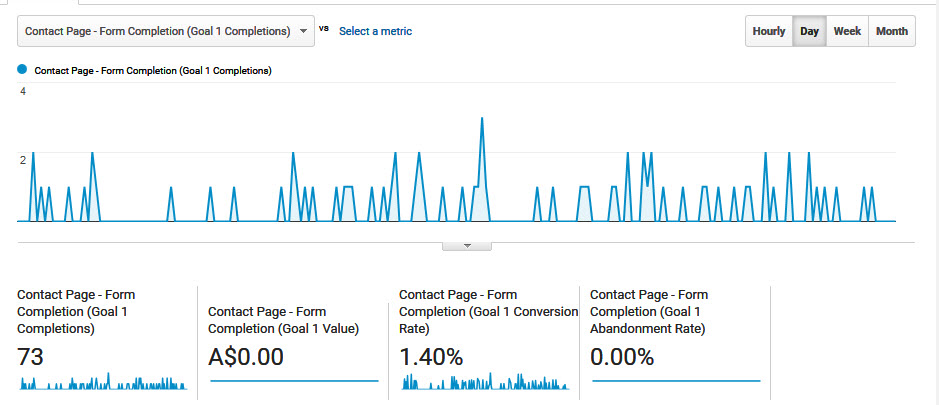What to do if Your Website is Not Performing – Part 3

In this last post in our series What to Do if Your Website is Not Performing - we take a look at the key metric of conversions.
- In Part 1 we looked at analysing your audience to make sure you’re attracting the right kind of people and analysing visitor engagement with the content on your site to see what’s of interest and what isn’t.
- In Part 2 we looked at traffic sources: where you’re traffic is coming from.
Once you have the right visitors on your site, you want them to take some kind of action before they leave. The action can be one or more of several things, depending on your objectives.
For most service businesses, it's to contact you. For ecommerce sites, it's to make a purchase. And for all kinds of businesses, you should also have some kind of list building strategy so you can stay in touch even if the visitors aren't quite ready to contact you or buy from you.
Tracking these actions is what we term conversion tracking, and this is how you can measure ROI - Return on Investment. If you're not tracking conversions against your objectives, then you're flying blind. After reading parts 1 and 2, you really should be spending effort on improving your content and marketing activities to get the right people to your site. But once they get there - if you don't know how many of them do the thing(s) you want them to do, then you won't have accurate metrics on whether all your efforts are working.
Here's three examples of conversion tracking to show you what's possible.
Tracking conversions - enquiries
There are two important ways to track how many people make enquiries.
1. Form completions
The first way is to track the number of people who fill out your enquiry forms, that you should have on every page of your site, and one on the contact page. In Google Analytics it's also possible to see on which page they completed the form, by viewing the Reverse Goal Path.

Figure 1 – enquiry form conversion tracking
Figure 1 above shows the number of people who have filled out the form on the contact page of this site, which belongs to a client of ours who operates a business in the services sector.

Figure 2: sidebar enquiry conversion tracking
Figure 2 from the same site shows that more than double the amount of people completed the enquiry form in the sidebar, than did on the contact page. Interesting isn't it! If we hadn't have included the enquiry form in the sidebar - would they have made their way to the Contact Page to make their enquiry? The easier you make it for people to contact you, the more likely they will.
2. Phone calls
A very clever conversion metric is the ability to track people who click your phone number on your website and call you. Yes this tracking type is limited to people calling you from their mobile phone, (or perhaps through skype on their desktop) and so doesn't capture people who call you without clicking the link, it's still a very useful method of tracking enquiries. If you don't have "click to call" set up on your site, or the conversion tracking - then you really do need to get it organised.

Figure 3 - click-to-call conversion tracking
Figure 3 shows the click to call results from another client, also in the services industry, in a different business type and city to the first one. To maintain client privacy we have blocked out some information, however you can see that Google Analytics provides very useful data on which pages of the site the client was on when they decided to call. For this site, the home page is still the top location, with 42% of people deciding to call when they reach the home page. I can tell you that the greyed out page locations of the other calls were made from blogposts. Shows you the incredible power of adding helpful blogposts to your site regularly.
Conversion tracking - sales
If you run an ecommerce site - then conversion tracking is an absolute must (even if it's not a full blown ecommerce site, but you offer any kind of products or services for purchase on your site). When conversion tracking is set up correctly, you can track abandonment rates on specific products or pages. You can conduct split testing of all kinds of things (landing pages, product images, buy buttons) etc and track conversion rates.

Figure 4 - ecommerce conversion tracking
Figure 4 shows tracking of one of my low cost ebooks. When I combine this information with other powerful reports in Google Analytics - like traffic sources and visitor demographics - I can tweak my marketing campaigns to try and improve results. If I then look at heat maps and see what information people are reading and which info they're skimming, I could conduct some split testing to move the information about on the page to see if that improves conversions. The possibilities are endless when you have the ability to accurately measure every variable.
Conversion Tracking - lead generation
As I mentioned earlier and in my article Building Your List, no matter what type of business you operate, building your prospect list is vital for future business, because you are never going to get all your website visitors to enquire or buy from you straight away. When you can capture visitors' email address by offering some kind of valuable ebook, report, tool or newsletter - you have the ability to stay in touch and keep building the relationship.

Figure 5 - lead generation
The stats in figure 5 are from a client who has an ecommerce site. Although there are a dozen one-off products for sale, we are currently in the process of building an extensive teaching program for him, aimed at one segment of his market. We have provided several valuable free downloads on the site as a way of building his list of this segment, so that when the course is ready to be launched, we will have a good-sized list of potential buyers ready to promote to. Our client stays in touch with the list regularly, providing tips and encouragement, and building excitement and momentum for the launch. This clever lead generation strategy means we already have a market of "hot" buyers ready to go and won't need to spend much on PPC advertising during the launch.
Get your conversion tracking working for you
There are so many ways to measure and increase conversions, and I've only just touched on three of them here.
It all depends on what you want to measure - and why.
It also depends on getting your conversion tracking set up correctly in Google Analytics. It is not dead easy, as there is a range of options and variables, but it's well worth the effort.
And of course, I've only mentioned Google Analytics conversion tracking. It's also possible to set up conversion tracking in Google Adwords and in Facebook advertising as well.
Like help setting up your conversion tracking?
If you'd like us to set up your conversion tracking for you, simply shoot us a message through our contact form and we'll be in touch to find out what you'd like to measure and discuss how we can help.

